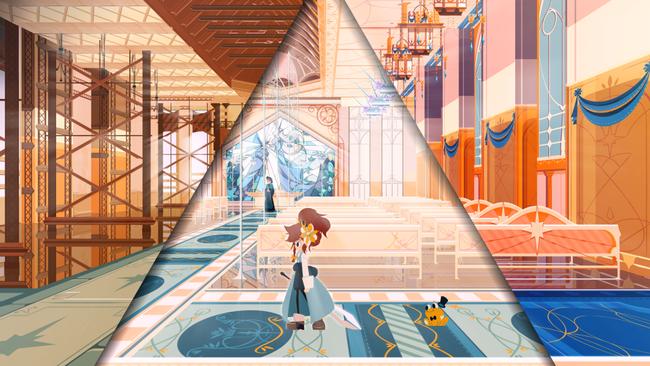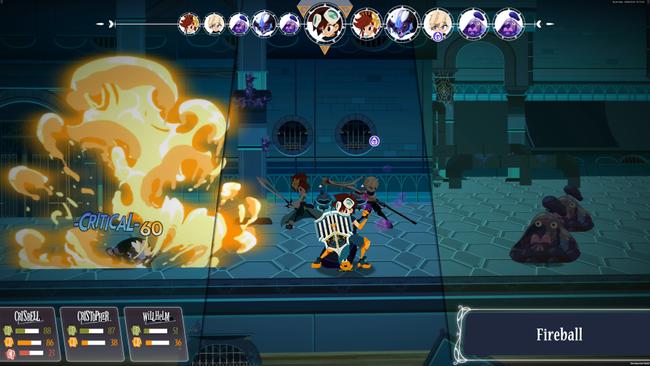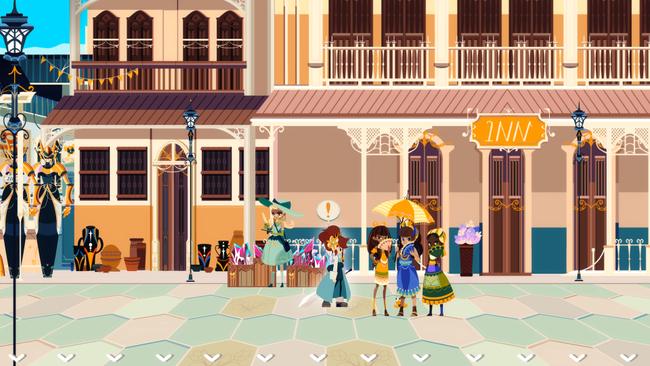
Cris Tales Preview: A time-bending homage to classic RPGs and a reflection of Colombian culture
Ever since its striking reveal at the PC Gaming Show during E3 2019, we've been keeping our eye on Cris Tales. It looks to be a colorful and visually distinct take on classic JRPGs, citing games like Chrono Trigger and Paper Mario as being primary inspirations for both the game's narrative as well as its gameplay style.
During the slew of streams this past weekend, the publishing team at Modus Games announced that Cris Tales will release for PC and consoles on November 17, with next-gen versions also in the works. Modus Games has been holding online hands-off preview streams to showcase how the game is shaping up, and we had a chance to sit in one of the preview sessions.

If you aren't familiar with the premise of Cris Tales, let me offer a short overview. Cris Tales stars a young time mage named Crisbell, a girl who gains the ability to not only see the past and the future but also manipulate time itself. This timeline premise manifests in the game both in and out of combat. When exploring town areas, for instance, the game shows the player three different time periods - the past, present, and future - simultaneously. The left-hand side of the screen depicts the past, while the right-hand side shows the future, reserving the center region for the present. This partition also plays a key role in combat, where portions of the battlefield can be manipulated to be set either in the past or future, and knowing how to exploit these splits to your advantage is key in mastering the game's battle system. When it comes to the timeshifting elements shown both in and out of battle, our preview from E3 2019 covers our thoughts on what has been shown so far, which still holds true at this point.
First impressions are important, and Cris Tales had a very good one in its debut at E3 2019 thanks to its distinct visual look and use of hand-drawn animation. The preview I saw for Cris Tales last week focuses on a few sections of the early parts of the game. We first saw some questing and dialogue in the city of St. Clarity, a location that was also highlighted in a gameplay video shared by Modus a few months back. I'll talk about the nuts and bolts shown of game mechanics in a minute, but some of the most interesting elements shared in these preview sessions didn't involve the presented, but rather the team that is found behind it.
Cris Tales is being developed by Dreams Uncorporated, an indie studio situated in Colombia - a South American country many people probably don't know much about. When discussing the unique visual design for the game, studio head Carlos Rocha Silva had several things to say. Character design, clothing design, location design - throughout the entirety of Cris Tales, Silva stated he wanted to emphasize elements often seen in Colombian life, history, & culture. When it came to the design of the main heroine, Crisbell, he sought to answer the question "How would a Disney Princess look if they came from Colombia".
As for the stylized virtual art style, Silva mentioned many sources of inspiration for it. Some anime, yes, but Silva more strongly mentioned how inspiration came from the works of artists like Genndy Tartakovsky (Samurai Jack), as well as Craig McCracken & Lauren Faust, with the cartoon Foster's Home for Imaginary Friends being a specifically cited example. Growing up in Colombia, Silva often got to experience small bits of other world cultures through classic RPGs as well as cartoons and anime. For Silva and the team at Dreams Uncorporated, Cris Tales is a project that pays some homage to these sources of inspiration, both mechanically and visually, while also hoping to return bits of Colombian culture to a worldwide audience.

Silva emphasized that elements of Colombian culture and history can be found throughout the world of Cris Tales. One of the earlier cities visited in the game is that of St. Clarity, a larger metropolis divided into both an upper-class walled region and lower-class slum area. The upper levels of St. Clarity have a design inspired by the real-world Colombian city of Cartagena, a port city founded in the 16th century known for its fortifications to defend against pirate attacks during the Spanish colonial period. One prominent piece of architecture found in the Cris Tales city of St. Clarity is a clock-adorned spire situated on an arch-way, which is a direct reference to a clock tower situated near the Plaza de los Coches in Cartagena. Another sanctuary in the game is based on the Santuario de las Lajas located in Ipiales. Other Colombian places of inspiration mentioned for Cris Tales include the island of San Andrés and the city of Santa Marta.
St. Clarity also features a sharp social divide between the upper-class citizenry, who reside in more elevated sections of the city, and the poorer class who make a living in the lower slums. The low-lying area of the city is often subject to flooding, partially from wastewater stemming from those who live higher up. While this may sound perhaps a bit on-the-nose written out in text, Silva described how for some Colombians, this is their lived reality. Not only is this flooding unsanitary, but it is also dangerous and something the people who live there have no choice but to acquiesce to. In fact, one of Crisbell's primary goals within the city of St. Clarity is to try to figure out how to resolve the tensions mounting between the various social classes that live there. How these things are included within Cris Tales "is not an accident", Silva says. Even small elements in the game often have Colombian-based roots, such as the character of Matias the frog, who is based on a poisonous frog well-known to anyone who lives in Colombia.
While the cultural inspirations and roots for Cris Tale are very interesting reasons to keep an eye on Cris Tales in their own right, the RPG systems in play also show quite a bit of promise. Combat in Cris Tales is turn-based, using both the game's time-shifting mechanics as well as Paper Mario-like timing elements in battle. A total of seven characters will be playable in Cris Tales, though only three have been revealed so far. Crisbell is your time mage, of course, but she also is quite handy with a sword. As a time mage, she can do quite a few tricks with her magic. For example, she can transform a group of enemy wolves into younger, weaker versions of themselves. Or she can take a squad of goblins and turn them into elderly golbins, which makes them frailer physically but also more adept at magic, so you do have to be a bit careful how you use her powers depending on the situation. Importantly, the development teams states there will be hints to the player to learn about the best ways to use Crisbell's time magic effectively, so it won't all be guesswork.

Joining Crisbell is Christopher, a more standard mage that can cast elemental magic like fire, water, and lightning. There is also Wilheim, another mage who performs plant-themed attacks, such as casting poison or planting poison bombs. Good timing by the player allows physical attacks to deal more damage, with perfect timing leading to follow-ups or critical hits. Additionally, good timing can also prevent characters from receiving status effects from enemy attacks, or on the flipside, can add status effects to attacks performed by the player. There are plenty of components in play within this turn-based battle system - time, elements, statuses, and good execution with attack timing all play a role in coming out on top.
Boss battles are events where Dreams Uncorporated really want the game's time-shifting mechanics to strongly play creative and unique roles in combat. One sequence I saw includes a creature fought in the St. Clarity sewers - a sewage-swimming monster that can swim around to either side of the stage, each of which existing in different places in 'time'. While the boss tries to maneuver in order to mitigate Crisbell's time powers, you can also use this to your advantage. For example, if you poison the boss while they are on the "past" side of the stage, once they move to the "future" side of the stage, the poison effects will instantly accumulate as if the boss has taken several turns while shifting forward in time.
Another boss shown in the demo has the capability to cancel Crisbell's time powers and set their location to the "present". However, before the boss does this, you can both poison the enemies and have Wilheim set a bomb, so that as soon as the time effect is canceled, both the bomb and poison effects will activate causing damage in your favor. Hopefully, the game has more interesting and creative takes on these sorts of time-shifting strategies without coming across as too gimmicky.

The time-shifting mechanic is also used in quests, of course. Like many RPGs, you can spend time talking with NPCs and earn various rewards for solving some problems in their lives. Of all the things shown in the demo, this was probably the component I came away least convinced about. The quests shown in the presentation used the time-mechanic, yes, but seemed to have blatantly simple solutions. For example, one NPC needed some blueprints to create a new device, but you soon learn the blueprints have been damaged over time. No worries, just easily grab the blueprints from the past instead and voilà, they are in perfect condition, and you can solve the quest. Another quest shown included an optional boss fight to save a child from drowning in the sewer. Hopefully, later quests in the game have less trivial solutions and more interesting uses of the game's time-shifting focus.
Not only do quests lead to some smaller monetary type rewards, but they can also influence larger outcomes for the game. For example, in the city of St. Clarity, you eventually can make a key decision who should lead the people of the city. You have various citizens you can choose from to take this role, and choices made in quests can affect who is available to step up to the plate.
Silva described that they wanted choices to have some significant consequences as well. Not always will there be an obvious best choice, and the player can make bad decisions as well. Depending on choices made, there might be some bits of content you'll be locked out of. Not necessarily a 'failure state', but consequences that directly result from decisions made from the player rather than just having two choices lead to effectively the same result with a different coat of paint. While Silva didn't want to offer any specifics, Cris Tales does also include multiple endings, emphasizing that variations on the game's ending would not just be a binary split between 'good and bad' conclusions.

Cris Tales is aiming for about a 20-hour runtime, thought Silva admits it might end up being longer than they originally anticipated due to all the content they've been able to create for the game.
Cris Tales has certainly caught my attention with its distinct artstyle, and it has shown some potential with its time-shifting premise. I'm eager to see if it fulfills that potential when it launches later this year. For those who can't wait to try it, the free demo on Steam has recently been updated with a colosseum mode, which you can check out right now.